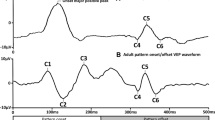Abstract
The sensitivity of transient, pattern-reversal visual evoked potentials in the detection of early compressive lesions of the chiasm is controversial in the literature. There have been claims that the technique is capable of detecting an abnormality in the absence of any demonstrable visual field loss, and conversely that VEPs are not reliable for the detection of chiasmal lesions even when a bitemporal hemianopsia is clearly recordable. Using nine patients with pituitary adenoma we attempted to quantify the extent of visual field loss and correlate the diagnostic capabilities of topographically recorded potentials following full- and half-field stimulus presentations of various field and check sizes. Differential light thresholds were measured and quantified according to one investigator's graticule for the neural representation of visual space. Results show a strong correlation between the degree of information loss and the diagnostic value of the visual evoked potential. The technique was, however, capable of detecting abnormality in the absence of recordable field loss when large field and check sizes were used.
Similar content being viewed by others
References
Halliday AM, Halliday E, Kriss A, McDonald WI, Mushin J. The pattern-evoked potential in compression of the anterior pathways. Brain 1976; 99: 357–74.
Blumhardt LD, Barrett G, Halliday AM. The asymmetrical visual evoked potential to pattern reversal in one half-field and its significance for the analysis of visual field defects. Br J Ophthalmol 1977; 61: 456–61.
Hume AL, Cant BR. Pattern visual evoked potential in the diagnosis of multiple sclerosis and other disorders. Proc Aust Assoc Neurol 1976; 13: 7–13.
Onofrj M, Bodis-Wollner I, Mylin L. Visual evoked potential diagnosis of field defects in patients with chiasmatic and retrochiasmatic lesions. J Neurol Neurosurg Psychiatry 1982; 45: 294–302.
Holder GE. The effects of chiasmal compression on the pattern visual evoked potential. Electroencephalogr Clin Neurophysiol 1978; 45: 278–80.
Clement R, Flanagan JG, Harding GFA. Source derivation of the visual evoked response to pattern reversal stimulation. Electroencephalogr Clin Neurophysiol 1985; 62: 74–6.
Aminoff MJ, Maitland CG, Kennard C, Hoyt WE. Visual evoked potential and field defects. In: Nodar RH, Barber C, eds. Visual evoked potentials: clinical application. London: Butterworths, 1984: 329–34.
Maitland MJ, Aminoff C, Kennard C, Hoyt WF. Evoked potentials in the evaluation of visual field defects due to chiasmal or retrochiasmal lesions. Neurology 1982; 32: 986–91.
Doeschatte JT. Perimetric charts in an equivalent projection allowing a panmetric determination of the extension of the visual field. Ophthalmologica 1947; 113: 257–70.
Crick RP. A system of visual field testing and recording using a parabolic projection. Trans Ophthalmol Soc UK 1957; 77: 593–607.
Drasdo N, Peaston WC. Sampling systems for visual field assessment and computerised perimetry. Br Ophthalmol 1980; 64: 705–12.
Drasdo N. The neural representation of visual space. Nature 1977; 266: 544–56.
Flanagan JG, Drasdo N, Harding GFA. The neural representation of the visual field-automated assessment and interpretation. Ophthalmic Physiol Opt 1983; 4: 188.
Yiannikas C, Walsh JC. The variation of the pattern shift visual evoked response with the size of the stimulus field. Electroencephalogr Clin Neurophysiol 1983; 55: 427–35.
Celesia GG, Daly RF. Effect of aging on visual evoked responses. Arch Neurol 1977; 34: 403–7.
Blumhardt LD, Halliday AM. Hemisphere contribution to composition of the pattern-evoked potential waveform. Exp Brain Res 1979; 36: 53–69.
Kriss A, Carroll WM, Blumhardt LD, Halliday AM. Pattern and flash evoked potential changes in toxic (nutritional) optic neuropathy. In: Courjon J, Mauguiere F, Revol M, eds. Clinical applications of evoked potentials in neurology. New York: Raven Press, 1982; 11–9.
Vaughan HG, Katzman R. Evoked response in visual disorders. Ann NY Acad Sci 1964; 112: 305–19.
Cameron HH, Hedges TR, Aminlari A. Correlation of ocular findings and plain skull roentgenogram in pituitary adenoma. Ann Ophthalmol 1982; 14: 733–40.
DeVita E, Johnson B, Sodur AA. Optic nerve degeneration in tract hemianopsia. Invest Ophthalmol and Vis Sci 1987; 28 (suppl): 32.
Author information
Authors and Affiliations
Rights and permissions
About this article
Cite this article
Flanagan, J.G., Harding, G.F.A. Multi-channel visual evoked potentials in early compressive lesions of the chiasm. Doc Ophthalmol 69, 271–281 (1988). https://doi.org/10.1007/BF00154408
Issue Date:
DOI: https://doi.org/10.1007/BF00154408




